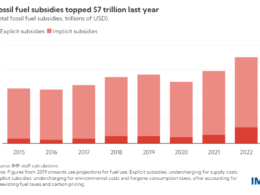Health Strategy Review
management, engineering and
technology review
Joaquim Cardoso MSc.
Founder and CEO of the “Health Strategy Institute (HSI)
- Senior Research and Strategy Officer (CRSO) —
for the Health Strategy Research - Chief Editor — for the Health Strategy Review
- Chief Advisor — for the Health Strategy Advisory
July 26, 2023
What is the message?
State Medicaid agencies have the untapped potential to play a leading role in driving efforts to reduce greenhouse gas emissions in the health care system.
With their significant purchasing power and unique levers, Medicaid agencies can foster the adoption of decarbonization measures in healthcare, thereby addressing the escalating threat of climate change
By doing so, Medicaid programs can become pioneers in creating a more sustainable and resilient health care system.

What are the key takeaways?
The health care sector accounts for about 8.5% of harmful greenhouse gas (GHG) emissions, largely attributed to hospital care, physician and clinical services, and prescription drugs.
State Medicaid agencies have a collective $800 billion purchasing power and unique levers like payment structures, policy pathways, partnerships, and measurement to reduce harmful GHG emissions in the health care system.
- Federal approaches to restricting GHG emissions have faced challenges, leading states and municipalities to take on a more prominent role in climate change mitigation.
State Medicaid programs can use tactics like Section 1115 waivers, innovative payment structures, quality measures, and partnerships to foster the adoption of decarbonization measures in the health care system.
- Oregon’s Medicaid program is already using a 1115 waiver to distribute devices like air conditioners and air filters to protect beneficiaries from climate-related risks, setting an example for other states.
Climate change impacts health through health-related social needs (HRSNs), and Medicaid agencies can align priorities by addressing climate-related risks while reducing GHG emissions.
- State Medicaid programs are already initiating climate action and can serve as models for other health policy areas to further impact and expand adaptation and mitigation efforts.
Collaboration and learning from successful initiatives are crucial for state Medicaid programs to become pioneers in reducing GHG emissions, creating a more sustainable and resilient health care system.
DEEP DIVE [original publication]

The Untapped Potential of Medicaid to Reduce Greenhouse Gas Emissions
Commonwealth Fund
Paul Shattuck, Senior Fellow, Mathematica
Corrie Haley, Senior Managing Consultant, Mathematica
Emily Cross Researcher, Mathematica
July 19, 2023
Vehicles move along the New Jersey Turnpike near Carteret, where a factory emits smoke. State Medicaid agencies can play a leading role in driving decarbonization efforts in the health care system. Photo: Kena Betancur/VIEWpress/Corbis via Getty Images
Toplines
- State Medicaid programs could play a stronger role in reducing greenhouse gas emissions by leveraging their purchasing and regulatory powers
- Oregon’s Medicaid program is using a 1115 waiver to distribute devices like air conditioners and air filters to protect beneficiaries from climate-related risks
The escalating threat of climate change poses significant risks to public health, as acknowledged by the World Health Organization and the American Public Health Association. The health care sector itself accounts for about 8.5 percent of harmful greenhouse gas (GHG) emissions, largely attributed to hospital care, physician and clinical services, and prescription drugs. State Medicaid agencies can play a role in “mitigation” or “decarbonization” — that is, reducing these harmful emissions — by leveraging the agencies’ collective $800 billion purchasing power. In addition, Medicaid has a unique set of levers available, including payment structures, policy pathways, partnerships, and measurement.
But state Medicaid agencies face challenges in terms of aligning priorities and acting on climate change mitigation because of limited operating budgets and competing demands, like responding to urgent health issues like COVID-19 and opioid drug use. This blog post considers how Medicaid agencies can use their untapped potential to reduce harmful greenhouse gas emissions within these parameters.

States vs. Federal Government
As federal approaches to restricting GHG emissions falter, states and municipalities are taking on a more prominent role. For instance, the Supreme Court ruled in June 2022 in its West Virginia vs. the Environmental Protection Agency (EPA) decision that the EPA had limited capacity to enforce regulations aimed at reducing GHG emissions. But in the same year, Congress passed the Inflation Reduction Act (IRA), which provides funding for climate change initiatives at local and state levels. The IRA authorizes block grants to states that can be used to address goals related to reducing GHG emissions. This new stream of funding strengthens the role of states as leaders in decarbonization policy.

How Medicaid Can Act
State Medicaid programs have substantial purchasing power and regulatory capacities that could be used to foster the adoption of decarbonization measures. Tactics Medicaid programs can use to influence providers’ operations include Section 1115 waivers, innovative payment structures and quality measures, and multisector partnerships (e.g., with transportation or housing agencies). For example, in its 1115 waiver — used to test or pilot innovations in Medicaid — Oregon’s Medicaid program included various health-related social need (HRSN) services to protect beneficiaries from climate-related risks. This includes distributing devices to maintain healthy living conditions like air conditioners, air filtration devices, and generators. Addressing climate-related risks in Medicaid waivers represents a significant step forward in terms of climate change action. Approval from the Centers for Medicare and Medicaid Services indicates that support, or at least flexibility, for similar actions is feasible.
Because the health of Medicaid participants is often affected by climate change via the impact on HRSNs — for instance, when extreme weather impacts housing or food security — these priorities and efforts are aligned. Some states are responding to climate-related risks like heat waves, wildfires, hurricanes, and vector-borne illnesses (e.g., Lyme disease) by developing and implementing climate action plans to protect the health of residents from these risks. Many of these measures can simultaneously advance decarbonization. For example, state Medicaid agencies can protect Medicaid participants’ health from climate-related risks while contracting with appliance suppliers to supply approved and medically necessary home environment modifications (e.g., air conditioners, heaters, and air filtration devices) that produce low or no emissions.

Best Practices for Other States and Related Public Sectors
Our recently published research highlights how state Medicaid programs are initiating climate action and sharing information across states. Looking ahead, other state health policy areas — departments of aging, maternal and child health, developmental disabilities, and public health — can follow Medicaid’s lead and further the impact. Policy leaders can collaborate, learn from one another, and continue to expand adaptation and mitigation efforts widely.

Conclusion
State Medicaid agencies can play a leading role in driving decarbonization efforts in the health care system. As in Oregon, Medicaid programs are already taking bold and innovative action to address HRSNs and respond to climate-related risks. With Medicaid climate-related policies and initiatives in their early formative phases, now is the time to ensure state Medicaid agencies understand the possibilities for addressing decarbonization goals alongside climate change adaptation goals and other agency priorities. By working collaboratively and learning from successful initiatives, state Medicaid programs can become pioneers in reducing GHG emissions, paving the way for a more sustainable and resilient health care system.
Originally published at https://www.commonwealthfund.org











